Text
BOTD: Tody Motmot

Photo: Salvador Poot Villanueva
"Small and infrequently seen bird of shady forest understory in humid tropical lowlands. Rather inactive. Sits quietly, mainly at low to middle levels, and occasionally wags its tail slowly. Usually not seen until flushed, when flies off with a low whirr of wings. Note the overall drab greenish plumage with a rusty cap and bushy whitish whisker marks. Much smaller than other motmots and lacks the racket tail tips of most larger motmot species."
- eBird
#birds#tody motmot#birds of north america#north american birds#motmots#birds of mexico#birds of central america#birding#bird watching#birdblr#birblr#bird of the day#Hylomanes momotula
23 notes
·
View notes
Text
BOTD: Plain Pigeon
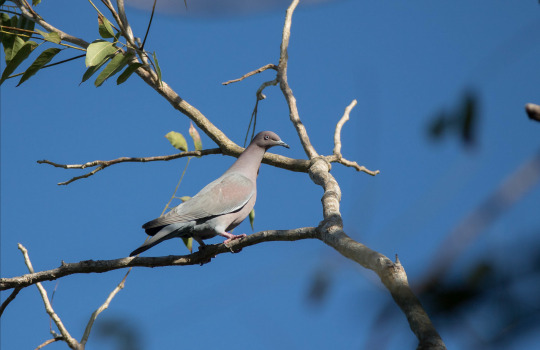
Photo: budgora
"A large pale pigeon of woodlands and forest edges; often found perching high in trees. Call is a soft, deep 'HOOO-hoo-hoooo' and variations thereof but never similar to 'oooOOO-hooo' of Ring-tailed Pigeon."
- eBird
#birds#plain pigeon#birds of north america#north american birds#pigeons#doves#birds of the caribbean#birding#birdblr#birblr#bird watching#bird of the day#Patagioenas inornata
27 notes
·
View notes
Text
BOTD: California Thrasher
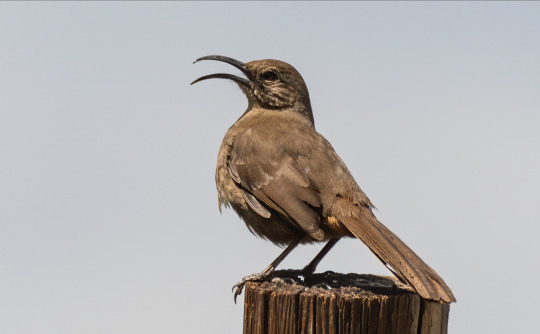
Photo: Wendy Miller
"Several kinds of dull gray-brown thrashers occur in the West, but this is the only one along the California coast. The bird's normal range is limited to California and a corner of Baja, but within that range it is quite common in the chaparral, even coming into brushy suburbs. It spends most of its time on the ground, walking and running with its tail often held high, stopping to dig in the dirt with its sickle-shaped bill."
- Audubon Field Guide
#birds#california thrasher#birds of north america#north american birds#passerines#thrashers#mimids#birds of the us#birds of mexico#birding#bird watching#birdblr#birblr#bird of the day#Toxostoma redivivum
30 notes
·
View notes
Text
BOTD: Abert's Towhee

Photo: Mick Thompson
"Along streams in the desert Southwest, a sharp pinging note in the thickets announces the presence of Abert's Towhee. If an observer tries to approach, a pair of these towhees may stay just ahead and out of sight, calling in an odd squealing duet when pressed too closely. When undisturbed, they feed on the ground under dense bushes, scratching among the leaf-litter. Many southwestern 'specialty birds' have extensive ranges in the tropics, but this towhee barely gets across the border into northwestern Mexico."
- Audubon Field Guide
#birds#abert's towhee#birds of north america#north american birds#towhees#sparrows#passerines#birds of the us#birds of mexico#birding#bird watching#birdblr#birblr#bird of the day#Melozone aberti
19 notes
·
View notes
Text
BOTD: Jamaican Owl
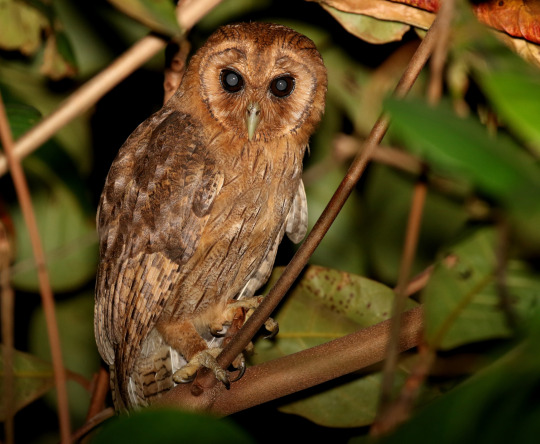
Photo: guyincognito
"A somewhat large nocturnal inhabitant of wooded areas including gardens and parks; roosts in tree cavities or dense foliage during the day. The Barn Owl is of similar size, but it is much paler and lacks the Jamaican Owl’s prominent ear tufts. Vocalizations include a low, gruff 'wa-waaa-o' and a crescendo/decrescendo 'whoa.'"
- eBird
#birds#jamaican owl#birds of north america#north american birds#owls#birds of prey#raptors#birds of central america#birding#birdblr#birblr#bird watching#bird of the day#Asio grammicus
43 notes
·
View notes
Text
BOTD: Dull-mantled Antbird

Photo: Charles Davies
"Medium-sized antbird with plump body and short tail. Gray body and brown back. Look for red eye and small white spots on shoulder. Female similar to male but slightly paler. Found inside forest, always close to the ground and usually in gullies near streams. Usually in pairs. Song is a good clue to its presence: listen for high, thin whistles, the first few higher and the last several dropping in pitch."
- eBird
#birds#dull mantled antbird#birds of north america#north american birds#antbirds#passerines#birds of central america#birding#birdblr#birblr#bird watching#bird of the day#Sipia laemosticta
23 notes
·
View notes
Text
BOTD: Gila Woodpecker

Photo: Mick Thompson
"A brash, noisy woodpecker of desert regions. Common and conspicuous in stands of saguaro, or giant cactus, it also lives in the trees along desert rivers, and is quick to move into towns and suburbs. This species and the Gilded Flicker are the two main architects of desert apartment houses: the holes they excavate in giant cactus are later used as nesting sites by many other birds, from flycatchers and martins to owls and kestrels."
- Audubon Field Guide
#birds#gila woodpecker#birds of north america#north american birds#woodpeckers#birds of the us#birds of mexico#birding#bird watching#birdblr#birblr#bird of the day#Melanerpes uropygialis
46 notes
·
View notes
Text
BOTD: Bronzed Cowbird
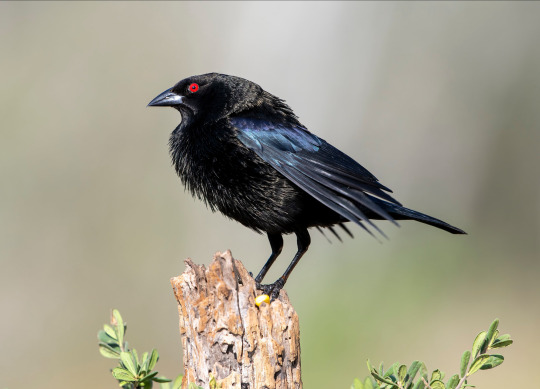
Photo: Doug Greenberg
"Larger than the Brown-headed Cowbird and mostly restricted to the Southwest, this species is another brood parasite. It may be more specialized in its choice of 'hosts,' and is thought to have seriously affected populations of some species, such as Hooded Orioles in southern Texas. The Bronzed Cowbird has expanded its range in our area during the last century; in Arizona, where it is now common, it was unrecorded before 1909."
- Audubon Field Guide
#birds#bronzed cowbird#birds of north america#north american birds#cowbirds#blackbirds#passerines#birds of the us#birds of mexico#birds of central america#birding#birdblr#birblr#bird watching#bird of the day#Molothrus aeneus
84 notes
·
View notes
Text
BOTD: Yellow-eared Toucanet

Photo: Cathie Barron
"Small toucan with distinctive plumage pattern. Male has black body with bright yellow cheek patch; also note olive back and orange patch on flanks. Female similar; she lacks the yellow cheek patch but still has bright yellow-teal skin around the eye. Found in the forest canopy, usually in pairs or small family groups. Feeds on fruits, and sometimes perches conspicuously on an open branch."
- eBird
#birds#yellow eared toucanet#birds of north america#north american birds#toucans#toucanets#birds of central america#birding#bird watching#birdblr#birblr#bird of the day#Selenidera spectabilis
36 notes
·
View notes
Text
BOTD: Mountain Thrush

Photo: Greg Lasley
"Rather dull-colored large thrush of mountain forests, rarely encountered. Feeds mainly in fruiting trees and bushes, less often on the ground. Both sexes gray-brown overall with a black bill and dark legs."
- eBird
#birds#mountain thrush#birds of north america#north american birds#mountain robin#thrushes#passerines#birds of mexico#birds of central america#birding#birdblr#birblr#bird watching#bird of the day#Turdus plebejus
29 notes
·
View notes
Text
BOTD: Common Merganser
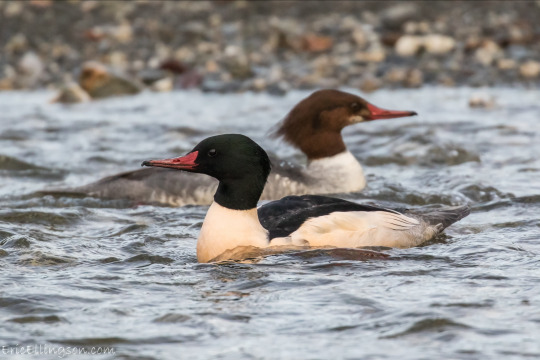
Photo: Eric Ellingson
"This fish-eating duck is the typical merganser of freshwater lakes. Its flocks are usually small, but these may combine into big concentrations sometimes at large reservoirs. Common Mergansers living along rivers may spend hours resting on rocks or on shore. The British call this bird the 'Goosander.' In some parts of Europe, with artificial nesting sites provided, the species has become a common nesting bird along city waterfronts; this has not yet happened in North America."
- Audubon Field Guide
#birds#common merganser#birds of north america#north american birds#ducks#mergansers#waterfowl#birds of the us#birds of canada#birds of mexico#birding#bird watching#birdblr#birblr#bird of the day#Mergus merganser
30 notes
·
View notes
Text
BOTD: Hooded Grosbeak
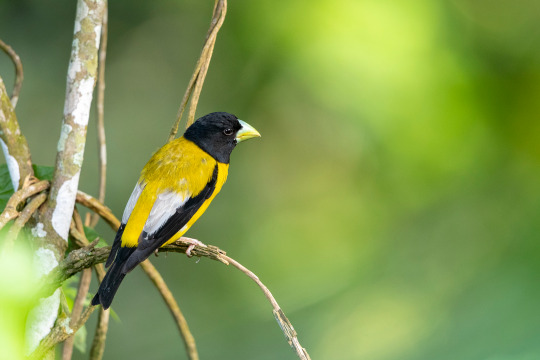
Photo: Niall Perrins
"Handsome, chunky finch of humid evergreen and pine-evergreen forest in foothills and highlands. Usually in pairs or small groups, feeding on fruit in canopy or seen in flight high overhead, when best detected and identified by call."
- eBird
#birds#hooded grosbeak#birds of north america#north american birds#grosbeaks#finches#passerines#birds of mexico#birds of central america#birding#birdblr#birblr#bird of the day#bird watching#Coccothraustes abeillei
29 notes
·
View notes
Text
BOTD: Prairie Falcon
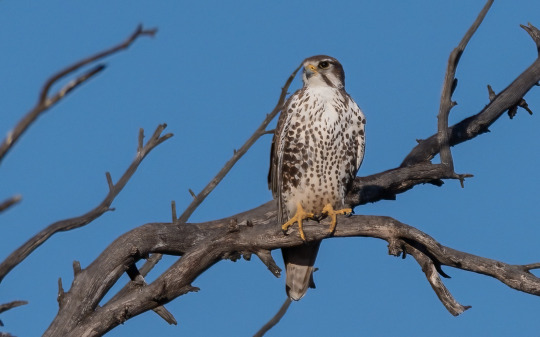
Photo: Wendy Miller
"A large falcon of the arid west. The Prairie Falcon is nearly the size of the famous Peregrine, but differs in its hunting behavior, often pursuing small prey with rapid, maneuverable flight close to the ground. Although it is characteristic of desolate plains and desert wilderness, this falcon has also adapted to altered landscapes: in winter, it is often seen flying over southwestern cities, or hunting Horned Larks in farm country."
- Audubon Field Guide
#birds#prairie falcon#birds of north america#north american birds#falcons#birds of prey#raptors#birds of the us#birds of canada#birds of mexico#birding#birdblr#birblr#bird watching#bird of the day#Falco mexicanus
36 notes
·
View notes
Text
BOTD: Scaly-throated Foliage-gleaner

Photo: Francisco Enríquez
"Rather active, arboreal bird of humid evergreen forest in foothills and highlands. Forages at all levels clambering along branches and amid mossy tangles and epiphytes, at times hanging upside down like a chickadee. Often in pairs or small groups; frequently joins mixed-species feeding flocks."
- eBird
#birds#scaly throated foliage gleaner#birds of north america#north american birds#ovenbirds#passerines#foliage gleaners#birds of mexico#birds of central america#birding#birdblr#birblr#bird watching#bird of the day#Anabacerthia variegaticeps
30 notes
·
View notes
Text
BOTD: Emerald Tanager

Photo: Doug Greenberg
"Well-named tanager, mostly emerald-green with trapezoidal black cheek patch, back streaking and wing markings. Small and active, usually found in pairs following mixed feeding flocks in foothill forests and edges. Feeds on fruit. Sexes alike."
- eBird
#birds#emerald tanager#birds of north america#north american birds#tanagers#passerines#birds of central america#birding#bird watching#birdblr#birblr#bird of the day#Tangara florida
42 notes
·
View notes
Text
BOTD: Willet

Photo: Andy Reago & Chrissy McClarren
"A Willet standing on the beach is simply a large plain shorebird; but its identity is obvious as soon as it spreads its wings, and it even calls its name in flight. Two distinct populations inhabit North America, one nesting in prairie marshes, the other in salt marshes along the Atlantic and Gulf Coasts. In favorable areas in the middle Atlantic states, Willets are abundant, nesting in colonies, their ringing calls echoing across the tidelands on spring mornings."
- Audubon Field Guide
#birds#willet#birds of north america#north american birds#shorebirds#wading birds#waders#sandpipers#birds of the us#birds of canada#birds of mexico#birds of central america#birds of the caribbean#birding#birdblr#birblr#bird watching#bird of the day#Tringa semipalmata
20 notes
·
View notes
Text
BOTD: Boat-tailed Grackle

Photo: Judy Gallagher
"Until the 1970s, this big blackbird was considered to be the same species as the Great-tailed Grackle, but the two forms overlap on the coasts of Texas and Louisiana without interbreeding. The Boat-tail is a more aquatic creature, nesting in marshes, scavenging on beaches. Except in Florida, it is seldom found far away from tidewater. Boat-tailed Grackles nest in noisy colonies, the males displaying conspicuously with much wing-fluttering and harsh repeated calls."
- Audubon Field Guide
#birds#boat tailed grackle#birds of north america#north american birds#grackles#blackbirds#birds of the us#birding#bird watching#birdblr#birblr#bird of the day#Quiscalus major
51 notes
·
View notes